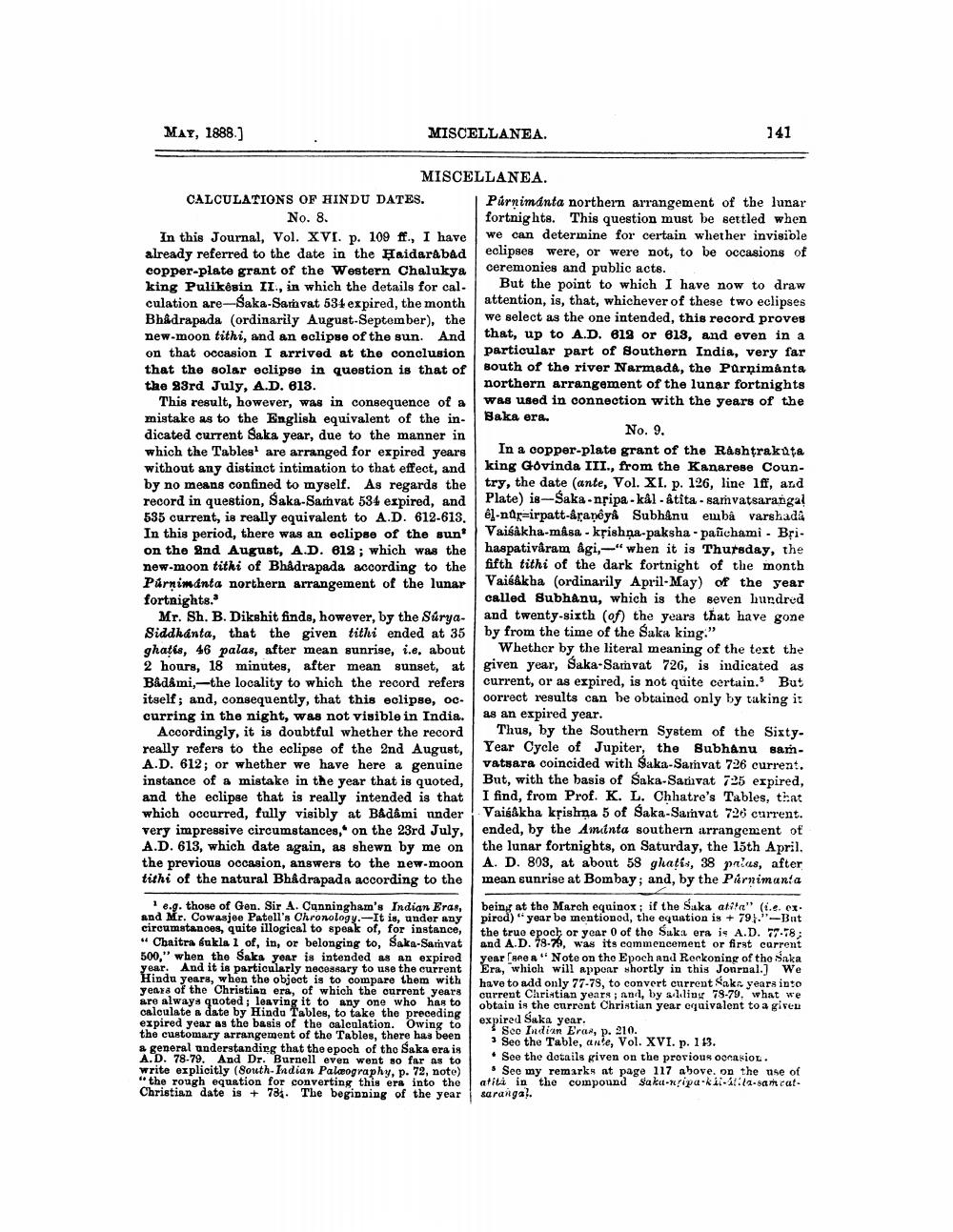________________
MAY, 1888.)
MISCELLANEA.
141
MISCELLANEA. CALCULATIONS OF HINDU DATES.
Purnimanta northern arrangement of the lunar No. 8.
fortnights. This question must be settled when In this Journal, Vol. XVI. p. 109 ff., I have we can determine for certain whether invisible already referred to the date in the Haidarabad eclipses were, or were not, to be occasions of copper-plate grant of the Western Chalukya ceremonies and public acts. king Pulikesin II, in which the details for cal. But the point to which I have now to draw culation are-Saka-Samvat 534 expired, the month attention, is, that, whichever of these two eclipses Bhadrapada (ordinarily August-September), the we select as the one intended, this record proves new-moon tithi, and an eclipse of the sun. And that, up to A.D. 618 or 613, and even in a on that occasion I arrived at the conclusion particular part of Southern India, very far that the solar eclipse in question is that of south of the river Narmada, the Parnimanta the 83rd July, A.D. 813.
northern arrangement of the lunar fortnights This result, however, was in consequence of a was used in connection with the years of the mistake as to the English equivalent of the in- Baka ere. dicated current Saka year, due to the manner in
No. 9. which the Tables are arranged for expired years
In a copper-plate grant of the Rashtrakata without any distinct intimation to that effect, and king Govinda III., from the Kanarese Counby no means confined to myself. As regards the
try, the date (ante, Vol. XI. p. 126, line lff, and record in question, Saka-Samvat 534 expired, and Plate) is--Saka-npipa-kal -&tita -samvatsarangal 535 current, is really equivalent to A.D. 612-613. el-napirpatt-êranêyê Subhanu enuba varshada In this period, there was an eclipse of the sun Vaisakha-masa - kşishņa-paksha-panchami. Bri. on the 2nd August, A.D. 612 ; which was the haspativaram agi,"when it is Thursday, the new-moon tithi of Bhådrapada according to the
fifth tithi of the dark fortnight of the month Párnimanta northern arrangement of the lunar Vaisakha (ordinarily April-May) of the year fortnights.
called Subhanu, which is the seven hundred Mr. Sh. B. Dikshit finds, however, by the Sarya- and twenty-sixth (of the years that have gone Siddhanta, that the given tithi ended at 35 by from the time of the Saka king." ahalle 46 nalar, after mean aunrise. i.e. about whether by the literal meaning of the text the 2 hours, 18 minutes, after mean sunset, at I given year, Saka.Samvat 726, is indicated as Badami,--the locality to which the record refers current, or as expired, is not quite certain. But itself; and, consequently, that this eclipse, oc- correct results can be obtained only by taking it curring in the night, was not visible in India. as an expired year.
Accordingly, it is doubtful whether the record Thus, by the Southern System of the Sixtyreally refers to the eclipse of the 2nd August,
the eclipse of the 2nd August. Year Cycle of Jupiter, the Subhanu samA.D. 612; or whether we have here a genuine
vatsara coincided with Saka-Sarnvat 726 current. instance of a mistake in the year that is quoted, But, with the basis of Saka-Sativat 725 expired, and the eclipse that is really intended is that I find, from Prof. K. L. Chhatre's Tables, that which occurred, fully visibly at Bådâmi under Vaisakha krishna 5 of Saka-Sarnvat 726 current. very impressive circumstances, on the 23rd July, ended, by the Aminta southern arrangement of A.D. 613, which date again, as shewn by me on the lunar fortnights, on Saturday, the 15th April. the previous occasion, answers to the new-moon A. D. 803, at about 58 ghatis, 38 prias, after tithi of the natural Bhadrapada according to the mean sunrise at Bombay; and, by the Párnimania
e.g. those of Gen. Sir A. Cunningham's Indian Eras, being at the March equinox: if the Saka atile" (i.e. ex. and Mr. Cowasjee Patell's Chronology.-It is, under any pired) " year be mentioned, the equation is + 79:"-But circumstances, quite illogical to speak of, for instance,
the true epoch or year of the Suka era is A.D. 17.78; " Chaitra kukla 1 of, in, or belonging to, Saka-Samvat and A.D. 78-78, was its commencement or first current 500," when the Saks year is intended as an expired year (Hea" Note on the Epoch and Reckoning of the Saka year. And it is particularly necessary to use the current Era, which will appear shortly in this Journal.) We Hindu years, when the object is to compare them with
have to add only 77-79, to convert current Paks. years into years of the Christian era, of which the current years are always quoted, leaving it to any one who has to
current Christian years; and, by aliling 78-79. what we calculate a date by Hindu Tables, to take the preceding
obtain is the current Christian year equivalent to a given expired year as the basis of the calculation. Owing to
expired Saka year. the customary arrangement of the Tables, there has been
Seo Indian Erar, p. 210. a general understanding that the epoch of tho Saka era is
* See the Table, ante, Vol. XVI. p. 113. A.D. 78.79. And Dr. Burnell even went so far as to
• See the details given on the provious ooraviou. write explicitly (South Indian Palmography, p. 72, note) See my remarks at page 117 above, on the use of " the rough equation for converting this era into the atita in the compound Saku-aripa kii. 1-san cat. Christian date is + 784. The beginning of the year sarangal.
500," when this particularly 500. And it inhen the object of which there who hadi
is to compararrent years
Iwf the Christ the objecticessary to use expired
obtain is the carry




